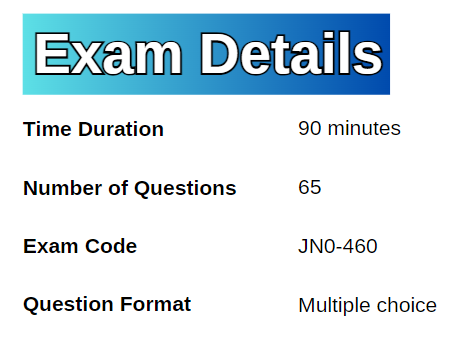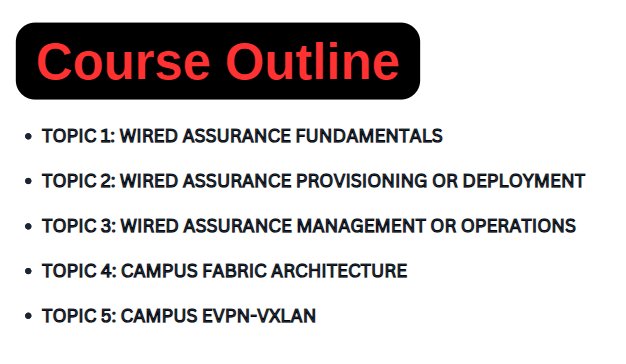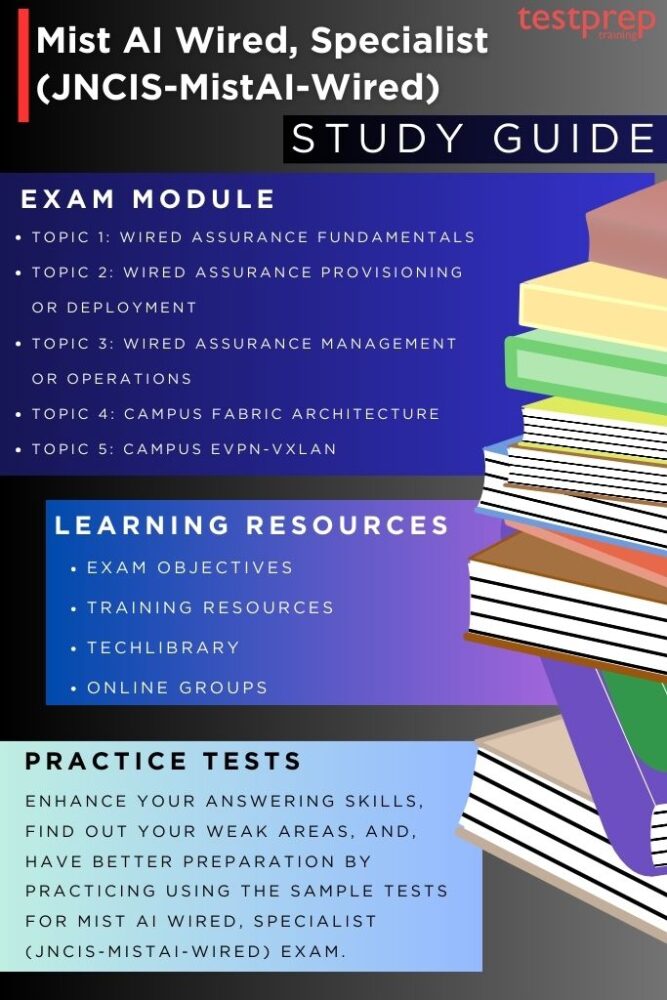Mist AI Wired, Specialist (JNCIS-MistAI-Wired)

The Mist AI track allows you to showcase a deep comprehension of the overall features and functions of Mist AI. The JNCIS-MistAI-Wired (JN0-460) is a specialist-level certification aimed at professionals with intermediate expertise in wired LAN networking utilizing Mist AI. This certification exam tests your intermediate-level knowledge of wired networking and Mist AI technology, along with its features and functions.
Exam Details

The JNCIS-MistAI-Wired (JN0-460) certification exam has a prerequisite exam JNCIA-MistAI and is administered by Pearson VUE. It has a time limit of 90 minutes and consists of 65 multiple-choice questions.
Course Outline
The JNCIS-MistAI-Wired (JN0-460) certification exam covers the following topics:

Topic 1: Wired Assurance Fundamentals
Identify the concepts or functionality of Wired Assurance fundamentals.
- Solutions
- Supported devices
- Features and components
- MistAI accounts
- Subscriptions
Topic 2: Wired Assurance Provisioning or Deployment
Identify the concepts of the provisioning or deploying wired assurance.
- Provisioning process
- Provisioning options
- Deployment options
- Configuration options
- Templates
- Supported architectures
- Site variables
Describe how to provision or deploy wired assurance.
Topic 3: Wired Assurance Management or Operations
Identify the concepts or functionality of wired assurance management or operations.
- Managing switches
- Port profiles
- Dynamic port configuration
- Service level expectations
- Client insights
- APIs
Describe how to manage or operate devices using MistAI wired assurance.
Topic 4: Campus Fabric Architecture
Identify the concepts of Campus Fabric Architectures
- EVPN multihoming
- Campus Fabric Core-Distribution
- Campus Fabric IP Clos
- GPB and Micro segmentation
- CRB versus ERB
- Scaling requirements
Describe how to deploy Campus Fabric Architectures.
Topic 5: Campus EVPN-VXLAN
Identify the concepts or functionality of VXLAN
- Layer 2 tunneling
- Data and control plane operations
- VTEP functions
- VXLAN gateways
Identify the concepts or functionality of EVPN
- Multipath
- Route types
- Ethernet Segment Identifiers
- Route distinguishers
- Route targets
- Policies
- Data and control plane operations
- MAC learning
Exam FAQs: JNCIS-MistAI-Wired (JN0-460)
Exam General Guidelines
Juniper Networks has established recertification criteria to maintain the high standards of JNCP certifications and ensure the ongoing relevance of certified individuals’ skills. These criteria are applicable across all JNCP certification tracks and are subject to potential revisions.
- Renewing certifications can be achieved by either passing an exam or completing a course at a higher level within the same track. This renewal also extends to all lower-level active certifications within the track, as well as any other active Associate-level certifications.
- Program participants have access to their certification status through CertMetrics and will receive periodic email notifications concerning their certifications. It is the responsibility of certification holders to keep both their certifications and contact information current.
- All JNCP certifications remain active for three years. Failure to renew certifications within this three-year period will result in their expiration.
Study Guide for JNCIS-MistAI-Wired (JN0-460)

1. Understand the Exam Objectives
Understanding the objectives of the JNCIS-MistAI-Wired (JN0-460) exam is crucial for successful preparation. These objectives outline the key topics and skills that will be evaluated, providing candidates with a clear roadmap for their studies. By reviewing the exam objectives, candidates can pinpoint areas that require additional attention, helping them create a focused study plan and use their time and resources wisely. Moreover, these objectives allow candidates to gauge their readiness and confidence, ensuring they have thoroughly covered all necessary topics and are well-prepared for the exam.
2. Use Juniper Recommended Training
Deploying and Managing Juniper Wired Networks for Campus and Branch with Mist AI:
This four-day course offers students an in-depth understanding of the Juniper Mist Wired Assurance solution, covering the three key stages of switch installations: Day Zero (Provisioning), Day One (Deployment), and Day Two (Operations). The course explores the technologies, software, and hardware that constitute traditional campus LANs and campus fabrics. It includes six modules that address Day One configuration, wired clients, site variable management, dynamic port configurations, campus fabric deployment, and the implementation of group-based policies (GBPs) and microsegmentation.
Students will gain practical experience through demonstrations and hands-on labs, focusing on provisioning, deploying, and managing Juniper EX Series and QFX Series switches. They will also deploy switches to create an Ethernet VPN–Virtual Extensible LAN (EVPN-VXLAN) campus fabric. All tasks will be performed in a dedicated lab using the Juniper Mist portal. The course content is based on the latest Mist version available at the time of course release, with Mist being a SaaS that updates biweekly. The labs emphasize implementing and managing switches using the Mist UI in both traditional campus and modern campus fabric architectures.
3. Use Juniper TechLibrary for Reference
Familiarizing yourself with the Juniper TechLibrary is essential for mastering Juniper Networks technologies. This TechLibrary offers a comprehensive collection of technical documentation, guides, configuration examples, and troubleshooting resources for Juniper products and solutions. By exploring the TechLibrary, users can understand the functionalities, configurations, and best practices for Juniper devices and software. Navigating the TechLibrary enables individuals to find documentation specific to their interests or areas of expertise, such as routing, switching, security, automation, or cloud solutions.
4. Join Study Groups
Participating in study groups or communities provides an excellent opportunity to enrich your learning experience. By joining groups that match your interests or certification goals, you can engage in discussions, exchange ideas, and learn from your peers. You also gain from the diverse insights and expertise of other members. These communities foster a supportive atmosphere where individuals assist, encourage, and guide one another.
5. Take Practice Tests
Taking practice tests for the exam is highly advantageous as it allows you to pinpoint your strengths and areas requiring improvement. This self-assessment boosts your ability to answer questions efficiently, enhancing your time management skills for the actual exam. It’s advisable to take these practice tests after completing each topic, as this reinforces your understanding of the study materials. Additionally, regular practice tests familiarize you with the exam format and types of questions, reducing anxiety and building confidence. By systematically evaluating your performance through these tests, you can develop a targeted study plan that addresses your weak points and maximizes your readiness for the exam.



